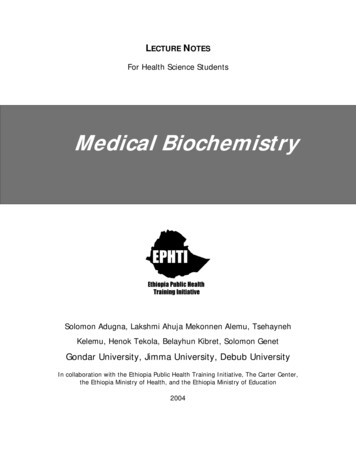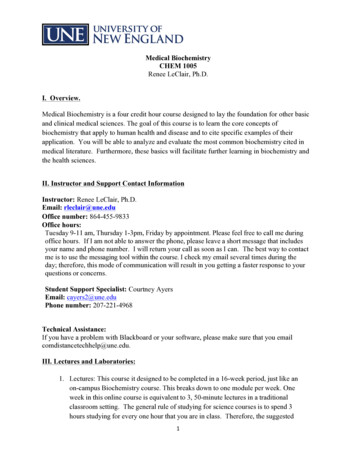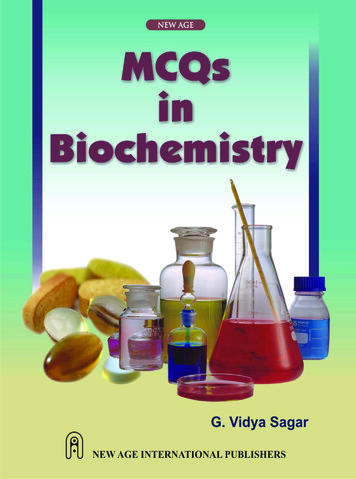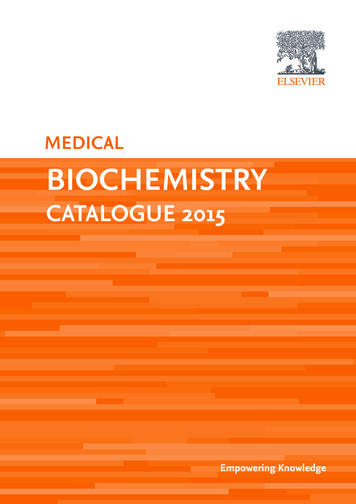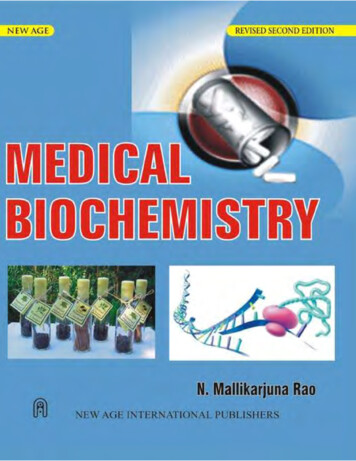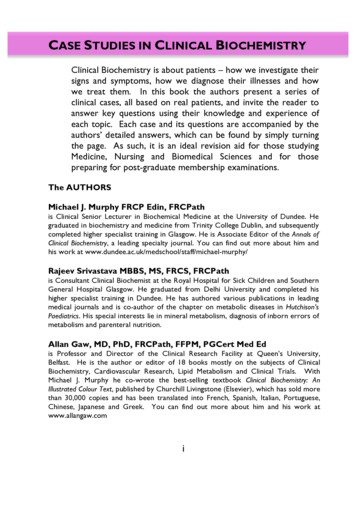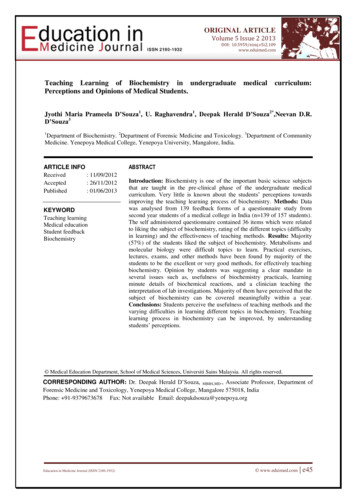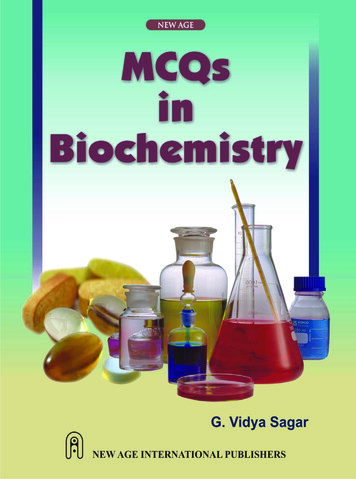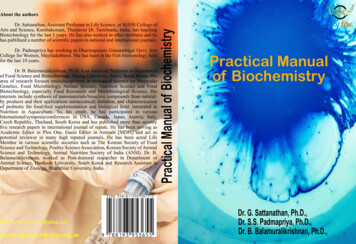
Transcription
Dr. Sattanathan, Assistant Professor in Life Science, at MASS College ofArts and Science, Kumbakonam, Thanjavur Dt. Tamilnadu, India, has teachingBiotechnology for the last 5 years. He has also worked in other institutes and hehas publihsed a number of scientific papers in national and international journals.Dr. Padmapriya has working in Dharmapuram Gnanambigai Govt. ArtsCollege for Women, Mayiladuthurai. She has been in the Fish Immunology fieldfor the last 10 years.Dr. B. Balamuralikrishnan, Ph.D. is an Assistant Professor in Departmentof Food Science and Biotechnology, Sejong University, Seoul, South Korea. Hisarea of research focuses multidisciplinary in biological science on MolecularGenetics, Food Microbiology, Animal Science, Nutrition Science and FoodBiotechnology, especially Food Resources and Microbiological Science. Hisinterests include synthesis of nanomaterials/bioactive compounds from naturalby products and their applications nutraceutical; isolation, and characterizationof probiotic for food/feed supplementation and biological field; interested inNutrition in Aquaculture. To, his credit, he has participated in variousInternational/symposia/conferences in USA, Canada, Japan, Austria, Italy,Czech Republic, Thailand, South Korea and has published more than seventyfive research papers in international journal of repute. He has been serving asAcademic Editor in Plos One, Guest Editor in Animals [MDPI] and act aspotential reviewer in many high reputed journals. He has been acted LifeMember in various scientific societies such as The Korean Society of FoodScience and Technology, Poultry Science Association, Korean Society of AnimalScience and Technology, Animal Nutrition Society of India (ANSI). Dr. B.Balamuralikrishnan, worked as Post-doctoral researcher in Department ofAnimal Science, Dankook University, South Korea and Research Assistant inDepartment of Zoology, Bharathiar University, India.Website: www.skyfox.coEmail:skyfox@skyfox.org.inPractical Manual of BiochemistryAbout the authorsPractical Manualof BiochemistryDr. G. Sattanathan, Ph.D.,Dr. S.S. Padmapriya, Ph.D.,Dr. B. Balamuralikrishnan, Ph.D.,
PracticalManual ofBiochemistryDr. G. Sattanathan, Ph.D.,Dr. S.S. Padmapriya, Ph.D.,Dr. B. Balamuralikrishnan, Ph.D.,
AUTHOR INFORMATIONSDr Sattanathan Govindharajan Ph.D.,Assistant ProfessorDepartment of Life ScienceMASS College of Arts and Science, Kumbakonam,Taminadu, IndiaDr Swaminathan Padmapriya Ph.D.,Guest LecturerDepartment Of ZoologyDharmapuram Gnanambigai Government Arts CollegeFor Women,Mayiladuthurai, Tamil Nadu, India.Dr Balasubramanian Balamuralikrishnan Ph.D.,Assistant ProfessorDepartment of Food Science and Biotechnology,College of Life Science, Sejong University,Seoul 05006, South KoreaFirst EditionCover Art and DesignISBNDOICopyright: December 2020: Authors: 978-81-939536-5-5: https://doi.org/10.22573/spg.020.BK/S/028: 2020 by Authors
Creative Commons Attribution-Share Alike 4.0 International LicenseYou are free: to Share — to copy, distribute and transmit the work; tomake commercial use of the work under the following conditions:Attribution — you must attribute the work in the manner specifiedby the author or licensor (but not in any way that suggests that, theyendorse you or your use of the work).No Derivative Works — you may not alter, transform, or build uponthis work.Publisher Contact &SupportSkyfox Publishing GroupSkyfox Press#987, Medical College RoadThanjavur-613004Tamil Nadu, India.Phone: 918300123232Email: skyfoxpublishing@gmail.com / skyfox@skyfox.org.inWebsite: www.skyfox.coHeadquarters &Marketing OfficeSkyfox Publishing Group333 Cedar Street, PO Box 208002,New Haven, United States.CT 06520-8002.Tel: 203.737.5603 / Fax: 203.785.7446Email: skyfoxpublishing@gmail.com / skyfox@skyfox.org.inWebsite: www.skyfox.co
PrefaceBiochemistry, a fascinating subject dealing with all the body'sfunctions and reactions. Clinical biochemistry has a tremendous effect onpatients' diagnosis and treatment. Medical students should be aware of theprocedures, the parameters of diagnosis and their estimations. Theyshould acquire sound knowledge of the diagnostic reports and theirconsequences that contribute to disease diagnosis and prognosis.The most rapidly growing subject is biochemistry, which isextensively applicable to molecular understanding of the disease.Estiamations of various biochemical parameters definitely provide aninsight into the normal metabolism and its aberrations, which form thebasis for medicine, leading to diseases. In relation to health and disease,biochemistry shpuld is encouraged that will make the topic moreinteresting and fascinating for the students. We hope that this practicalbiochemistry book will help medical students to think about the differentfacts found in the body's reactions.Dear students, let us admit that, given the fact that it is nonclinical, extensive, volatile and there is little in it to arouse any amount ofinterest in medical graduates, biochemistry is seldom a favorite of medicalgraduates. We have realized that practice is where they have shown someenthusiasm for biochemistry in our biochemistry teaching toundergraduate medical students.Our main objective is to make this book as simple and attractiveas possible for undergraduate biochemistry, allied biochemistry, medical,non-medical students, which is evident from the book's title. Eachpractical session has been reorganized to achieve this objective in such away that it is easy to understand. Wherever possible, the subject ispresented in tabular format so that it becomes very concise, and all testresults are given color so that one realizes the practice of the simple taskof reading the book itself. The basic concepts and values behind eachexperiment are explained in a simple manner.Our only real concern is to help you understand the subject in aneasy and organized way so that not only in your examinations, but also inyour future medical career, this little knowledge comes as a big help.To make this book a better one, we will be happy to acceptconstructive criticism and fruitful suggestions.Dr. K. SaravananPrincipal,MASS College of Arts and Science,Kumabkonam.
ACKNOWLEDGMENTSI would like to thank God for enabling me to do this work. Ithank my parents, teachers for molding me to reach thislevel. I extend my gratitude to my colleagues for theirsupport.
18.19.20.21.22.23.24.25.26.27.28.29.30.Rules and Procedures of General SafetyBuffer solution preparation And pH measurementIntroduction of CarbohydratesQualitative Analysis of CarbohydratesIntroduction of ProteinsTests for ProteinsIntroduction of AminoacidsTests on Amino AcidsQualitative Tests for LipidsSample CollcetionAnticoagulantsType of Collection ProceduresProximate AnalysisEstimation of Reducing Sugar by Benedict’s MethodEstimation of Protein by Lowrey’s MethodEstimation of Cholesterol by Zak’s MethodEstimation of DNA by Diphenylamine MethodSeparation of Amino Acids by TLCSeparation of Sugars by Paper ChromatographyEstimation of CSF Sugar By Trinders MethodEstimation of RNA by Orcinol ReactionDetermination of Reducing SugarsEffect of Temperatures on Salivary AmylaseEffect of pH on Salivary AmylaseEstimation of HaemoglobinEstimation of Hb by Cyanmethemoglobin MethodIsolation of Chloroplast DNAIsolation of MitochondriaIdentification of Lipids by TLCDetermination of Starch in Plant 75777880828486
.Isolation of Casein from MilkDetermination of The Acid Value of a FatSaponification Value of FatEstimation of Blood CholesterolIsolation of RNA From YeastEstimation of Chlorophyll ConcentrationDetermination of Total Erythrocyte CountDetermination of Total Leucocyte CountDetermination of Packed Cell Volume (PCV)Determination of Mean Corpuscular Volume (MCV)Determination of Mean Corpuscular HaemoglobinDetermination of Mean Corpuscular HaemoglobinCorpuscularDifferential Leukocyte CountDetermination of Serum AmylaseEstimation of Serum Uric AcidPhytochemical 03105117
1. RULES AND PROCEDURES OF GENERAL SAFETY1. Prior to attending that laboratory session, the laboratory procedures must beread.2. Laboratory smoking, eating and drinking are absolutely prohibited at anytime in the laboratory.3. Only closed-toe shoes should be worn in the lab. Due to the constant risk ofcuts and infections from broken glass found on the laboratory floors andthe possibility of chemical spills, sandals or open-toed or canvas shoes arenot allowed.4. Keep your face, nose, eyes, ears and mouth away from your hands and otherobjects. In the laboratory, the use of cosmetics in the laboratory isprohibited.5. Before and after use, work areas or surfaces must be disinfected.6. While in the laboratory, laboratory coats must be worn and buttoned.Outside of the laboratory, laboratory coats should not be worn.7. When conducting any exercise or procedure in the laboratory, protectiveeyewear must be worn.8. To minimize the fire hazard or contamination of experiments, long hairshould be secured behind your head.9. Prior to leaving the laboratory, hands must be washed.10. Coats, books and other paraphernalia, such as purses, briefcases, etc., shouldbe placed in specified locations when entering the laboratory and never onbench tops (except for your lab manual).11. Never mouth-pipet anything (including water). Always use appliances forpipetting.12. Label all materials with your name, date and any other informationapplicable (e.g., media,organism, etc.).13. Waste disposal in its proper containers (see Biohazard Waste Disposalbelow).14. Note the hazard code on the bottle when handling chemicals and take theappropriate precautions indicated.15. Do not pour down the sink with chemicals.16. Return to their appropriate places all chemicals, reagents, cultures, andglassware.17. Do not pour fluids that are biohazardous down the sink.1
Practical Manual of Biochemistry18. It is necessary to wash the glassware with soap and water, then rinse it withdistilled water.19. Flame transfer loops, wires, or needles for transferring biological materialbefore and immediately after use.20. Do not walk around the laboratory with infectious matter containingtransfer loops, wires, needles, or pipettes.21. Around Bunsen burners, be careful. It is not always possible to see flames.22. Turn off the incinerators before the laboratory leaves.23. Report any broken equipment, report any broken glass, in particular thosecontaining infectious materials immediately.24. Contact your course instructor or TA immediately if you are injured in thelaboratory.25. In the event of further treatment being required, spills, cuts and otheraccidents should be reported to the instructor or TA.26. Familiarize yourself with safety equipment and emergency escape routes inthe laboratory.27. Before putting it away, always wipe and clean your microscope's lenses. Tothis end, use the relevant tissue paper and cleaning solution.28. With all biological fluids, apply appropriate universal precautions.29. Without the written permission of the course instructor or TA, do notremove any materials from the laboratory.2
Practical Manual of Biochemistry2. BUFFER SOLUTION PREPARATION AND PHMEASUREMENTPrincipalA buffer's main purpose is to control the solution's pH. Bufferscan also play secondary roles in a system, such as controlling ionic strengthor species solving, perhaps even affecting the structure or activity of proteinor nucleic acid. Nucleic acids, nucleic acid-protein complexes, proteins, andbiochemical reactions are stabilized by buffers (whose products might beused in subsequent biochemical reactions). Complex buffer systems inelectrophoretic systems are used to control the pH and to establish the pHgradient. Weak acids and bases are made up of buffer solutions that makethem comparatively resistant to pH change. Theoretically, buffers offer aready source of both acid and base to either supply additional H if theprocess consumes H or if a reaction produces acid, combine it with excessH .Reagents:a. Acetic acid 0.2 M: glacial acetic acid 1.5 ml is made up to 100 ml by usingdistilled water.b. Citric acid: citric acid 2.10 gm in 100 ml distilled water.c. Dibasic sodium phosphate: 5.3 gm of disodium hydrogen phosphate in100 ml distilled water.e. Monobasic sodium phosphate: 2.78 gm sodium dihydrogen phosphate in100 ml distilled water.f. Sodium acetate solution: 0.64 gm of sodium acetate in 100 ml distilledwater.g. Sodium bicarbonate solution: sodium bicarbonate 1.68 gm in 100 mldistilled water.h. Sodium carbonate solution 0.2 M:2.12 gm anhydrous sodium carbonatein 100 ml distilled water.i. Sodium citrate solution 0.1 M: sodium citrate 2.94 gm in 100 ml distilledwater.Procedure:a. Acetic acid-sodium acetate bufferTake a 100 ml flask and use a pipette to add 36.2 ml of sodiumacetate solution, and then add 14.8 ml of glacial acetic acid to it. Using3
Practical Manual of Biochemistrydistilled water to produce a total volume of 100 ml. The resulting aceticacid-sodium acetate buffer is 0.2 M. With the help of a pH meter, the pH ismeasured. With distilled water, the electrode is washed, and then dipped inthe prepared buffer solution. The resultant pH is 4.6.b. Barbitone bufferIn distilled water, mix 2.85 gm of diethyl barbituric acid and 14.2gm of sodium diethyl barbititrate and then produce 1000 ml of finalvolume. That's the buffer of barbitone. With the help of the pH meter, thepH is measured, and the final pH comes out as 6.8.c. Citrate bufferUsing distilled water, mix 46.5 ml of citric acid with 3.5 ml ofsodium citrate solution and add 100 ml to the final volume. This is a citratebuffer of 0.1 M. With the help of a pH meter, the pH of this buffer ismeasured and the pH is 2.5.d. Carbonate-Bicarbonate bufferPut 27.5 ml of sodium carbonate solution in a flask and add 22.5ml of sodium bicarbonate solution to it. Then make 100 ml of the totalvolume with the aid of distilled water. This is a buffer of 0.2 M carbonatebicarbonate. The pH meter is standardized, and the pH of the buffersolution that is prepared is measured. The pH would be 10.2.e. Phosphate bufferDihydrogen sodium phosphate (39 ml) is mixed with disodiumhydrogen phosphate (61 ml), and 200 ml of distilled water is added to thefinal volume. This solution results in the phosphate buffer being 0.2 M.Using a pH meter, the pH of the phosphate buffer is measured and 6.8 isobtained.Preparation of solutions (Molar, Normal) and Dilutiona. Solution PreparationA solution is a homogeneous mixture produced in a solvent bydissolving one or more solutes. The smaller chemical, the solute, is solublein the solvent (the chemical present in a larger amount). As standard (stock)4
Practical Manual of Biochemistrysolutions, solutions with precisely known concentrations can be referred to.These solutions are purchased directly from the manufacturer or formed bydissolving the desired amount of solute into a specific volume volumetricflask. Stock solutions are often diluted into lower concentration solutionsfor experimental use in the laboratory.b. Preparing a Standard Solution from a SolidBy two similar methods, a solution of known concentration can beprepared from solids. Although there are inherent errors with each of themethods, either for making solutions in the General Chemistry Laboratorywill be sufficient with careful technique.In the first method, the solid solvent is weighed on paper or in asmall container and then transferred directly to a volumetric flask(commonly called a "vol flask"). In transferring the solid into the slim neckof the vol flask, a funnel could be helpful. In the vol flask, a small amountof solvent is then added and the contents are gently swirled until thesubstance is completely dissolved.More solvent is added until the liquid meniscus reaches thecalibration mark (a process called diluting to volume) on the neck of thevolume flask. Until the contents are mixed and completely dissolved, thevol flask is then capped and reversed several times. The drawback of thismethod is that the original container, weighing paper, or funnel can adhereto some of the weighed solid. Also, when it is transferred into the slim neckof the vol flask, solid can be spilled.In the second method, in a small beaker, the solid is weighed outfirst. A small amount of solvent is added to the beaker and until the solid isdissolved, the solution is stirred. The solution is then moved to the flask ofvol. Again a funnel may need to be inserted into the flask's slender neck.The beaker, stirring rod, and funnel must be carefully rinsed beforeadding additional solvent to the flask, and the washes added to the vol flaskto ensure that all remaining traces of the solution have been transferred.The vol flask is finally diluted to volume (additional solvent is added to the5
Practical Manual of Biochemistryflask until the liquid level reaches the calibration mark). As before the flaskis capped and inverted until the contents are mixed thoroughly. Thedownside to this technique is that if not thoroughly washed, some of thesolution may stick to the beaker, stirring rod, or funnel. Also, if they havenot been washed carefully, there is a chance of contamination from thebeaker, rod, or funnel.c. Molar SolutionIt consists of one mole of solvent in a solution equal to one liter.Molar solution Molecular weight in the solution in grams / liters.Example: Sodium chloride molar solution I (NaCl).Sodium atomic weight 23Chloride atomic weight 35.5Total molecular weight 58.5 gram / molNow dissolve 58.5 grams of NaCl in distilled water and make the solutionto one liter.d. Normal SolutionThe normal solution is defined as the solution's gram equivalentweight per liter.Normal solution gram equivalent solvent weight/solution liter.These alternatives are expressed as N.Gram equivalent weight weight/valence of moleculesExample1 N sodium chloride solution to make The NaCl molecular weight is 58.55. Gram equivalent NaCl weight molecular weight / 1 (valency)Dissolve 58.5 grams of NaCl in one liter of distilled water and make-up.e. Percent Solution1. This is per hundred of the total solution component.2. A percentage solution has three possibilities.Weight/weight is a solvent percentage equal to solute solvent in 100grams of final solution.1. Weight/weight is a solvent percentage equal to solute solvent in 100grams of final solution.6
Practical Manual of Biochemistry1. For example, dissolving 5 grams of NaCl in 95 grams of water,which is around 95 mL.2. The weight/volume of for example 5 grams of NaCl dissolved inwater and the volume of 100 ml is called a 5 percent NaCl solution.3. Two solutions consist of volume/volume. For example, if wetake 5 mL of acid and dilute it to 100 mL of water, that acid is a 5 percentsolution.f. The Dilution1. This procedure is very common for the preparation of serum dilutionwhere, if it is above 300 mg/dL, there is a high concentration of chemicalssuch as urea in the blood.2. If we manufacture a serum dilution like this:1. Serum 1 millilitre2. Diluting 4 mL of fluid3. This will be a dilution of 1:5 (1 4 5).7
Practical Manual of Biochemistry3. INTRODUCTION OF CARBOHYDRATESThis experiment is intended to introduce you to one of the threemajor classes of macronutrients found in food, carbohydrates. You will alsolearn a variety of ways to categorize carbohydrates and several tests used inthe analysis of carbohydrates.The experiment is composed of four parts that should becompleted in the order listed below (background, prelab, experiment,postlab).You may proceed directly to the section on carbohydrate tests ifyou are already familiar with carbohydrates.nCO2 n H2O energyCnH2nOn nO2It is possible to classify carbohydrates as simple or complex:1- Simple carbohydrates, often referred to as simple sugars ormonosaccharides, contain one unit of saccharide and cannot be brokendown into smaller carbohydrates.2- Those containing more than one group of saccharides are complexcarbohydrates.- Disaccharides contain two units of monosaccharide.- Oligosaccharides have 3-6 units of monosaccharides.- Over 7 or more monosaccharide units may be contained inpolysaccharides. Through a process known as hydrolysis, complexcarbohydrates can be broken down into smaller carbohydrate units.It is possible to classify monosaccharides in a number of ways.They can be categorized by the number of atoms of carbon they contain.While there are others, the most common are pentose (5 carbons) andhexose (6 carbons).Ketoses or aldoses may also be classified as monosaccharides. Inaddition to having one or more hydroxyl groups, ketose contains a carbonylgroup. Besides the hydroxyl groups, an aldose contains an aldehyde group.For an aldose or "aldohexose" for ketose, which is also a hexose, the twodescriptors are usually combined into a single term like "ketohexose". Seeseveral examples of monosaccharides below.8
Practical Manual of BiochemistryMonosaccharidesHydrolysis can break disaccharides into two monosaccharide unitsand lose one molecule of water.FDi-saccharidesOligosaccharides can be broken by hydrolysis into 3-6monosaccharide units and lose one or more water molecules, see theexample of oligosaccharides below.Poly-saccharidesPolysaccharides can be broken into 7 or more units of monosaccharides byhydrolysis and one or more molecules of water can be lost.9
Practical Manual of Biochemistry4. QUALITATIVE ANALYSIS OF CARBOHYDRATES1. SolubilityDue to the polar hydroxyl groups that form H-bonds with water,monosaccharides and oligosaccharides are readily soluble in water.However, due to their large molecular weight, the polysaccharides maketranslucent colloidal solutions.2. Qualitative tests for carbohydrates:There are several difficulties in their qualitative as well asquantitative analysis when analyzing a sample containing a mixture ofcarbohydrates, particularly sugar. These problems are attributed to theirstructural and chemical resemblance, as well as their stereoisomerism. It istherefore necessary to determine, during biochemical investigations,whether or not a given sample contains carbohydrates. In order to establishthe presence or absence of a sugar or a carbohydrate in a sample, severalrapid tests are available. Such tests are based on specific typical colorreactions for their group. It is advisable to carry out these tests with theindividual in the laboratory rather than with a sugar mixture. The sensitivityof these tests can be confirmed by using different concentrations of sugarsolutions (0.1- 1 percent ).A. General tests for carbohydrates:In order to detect the presence of carbohydrates in a solution, themost common tests used are:For all carbohydrates, whether free or in combined form, it is agroup test. It is routinely used to detect the presence of carbohydrates,despite its limitations.a. Molisch's TestPrincipleThe response is based on the fact that H2SO4 concentratedcatalyzes the dehydration of sugars to form furfural (from pentoses) orhydroxymethyl furfural (from hexoses). These furfurals then condense togive a purple or violet colored product with sulfonated alpha-naphthol.A ve reaction is also provided by polysaccharides and glycoproteins. The10
Practical Manual of Biochemistryacid first hydrolyses it into monosaccharides, which are then dehydrated toform furfural or its derivatives, in the case of the carbohydrate being a polyor disaccharide.Reagents(i) Conc.H2SO4(ii) Molisch's reagent: 5 percent (w/v) of alpha-naphthol in 95% ethanol.ProcedureTake 2 mL of the unknown solution and add the contents to the 2mixture. Incline the tube and pour 1-2 mL of conc.H2SO4 carefully downthe side of the tube. Tube so that a layer beneath the aqueous solutionforms the acid. The formation at the junction of two layers of a purple orviolet ring or zone indicates the presence of carbohydrates.Precautions:(i) The solution of alpha-naphthol is unstable and should be madefresh.(ii) Conc.H2SO4 should be carefully added along the sides of thetest tube, causing the contents of the tube to be minimally disturbed.Limitations:This test is also performed in addition to carbohydrates, furfuralsas such, certain organic acids, aldehydes and ketones. Secondly, due to thecharring action of acid, a concentrated sugar solution can give a red colourinstead of purple.b) Anthrone testPrincipleAnother general test for carbohydrates is anthrone reaction. Itsprinciple is the same as that of Molisch's, except that furfurals andhydroxyl-methyl furfurals offer bluish green condensation products withanthrone.ReagentsAnthrone reagent: in conc.H2SO4, 0.2% (w/v) solution.ProcedureIn a test tube, add about 2 mL of Anthrone reagent toapproximately 0.5-1mL of the test solution and mix thoroughly. Watch ifthe colour changes to bluish green. If not, after keeping them in a boilingwater bath for ten minutes, re-examine the tubes. A positive test indicates a11
Practical Manual of Biochemistryblue-green color.B. Specific tests for carbohydrates:a) Polysaccharide iodine testThis test is performed to differentiate polysaccharides from monoand disaccharides.PrincipleWith various polysaccharides, iodine forms coloured adsorptioncomplexes. Because of iodine adsorption on the polysaccharide chains,these complexes are formed. The colour intensity depends on the length ofthe available unbranched or linear chain for the complex formation.Therefore, amylose gives a deep blue color and amylopectin, theunbranched helical component of starch, the branched component givesred color because the chains do not effectively coil. Glycogen, which is alsohighly branched, adds iodine to the red colour. This experiment isperformed in acidic or neutral solutions.Reagents(i) Iodine solution: prepare a 2% (w/v) KI solution in water towhich a few iodine crystals are added until the solution is deep yellow.(ii) Starch solution: dissolve 1g of starch in about 10-20mL ofboiling water and add saturated sodium chloride solution to a volume of100mL.ProcedureIn a test tube, take 3 mL of the test solution and add 1-2 drops ofdil.HCl.Mix and then add 1-2 drops of the solution of iodine. Mix andobserve the change in colour. Heat the tube and again observe the colour.When heated, the blue colour disappears and reappears when cooled.(b) Tests based on the reduction of carbohydrate propertiesSugars with a free or potentially free group of aldehydes or ketonesact as reducing agents, and this becomes the basis for the tests carried outto distinguish them from non-reducing sugars. These sugars have the abilityto easily reduce alkaline metal solutions such as copper, bismuth, mercury,iron and silver. Aldo sugars are oxidized into the corresponding aldonicacids, whereas shorter chain acids are produced by keto sugars. If in the12
Practical Manual of Biochemistryabsence of sugar reduction, the alkaline copper solution is heated, the blackprecipitate of cupric oxide forms:Heat2OHCu (OH)2 -----------However the alkaline solution of copper is reduced to insolubleyellow or red cuprous oxide in the presence of a sugar reducer:HeatSugar 2 Cu(OH)2-------------------- 2O 2 H2OA) Fehling's testIn this reaction, Rochelle salt acts as a chelating agent:CuSO4 2KOH ------------ 2 K2SO42Cu(OH)2 Reducing Sugar ------------ 2O Aldonic acidReagentsi) Fehling solution A:Dissolve 69.38 g of copper sulfate in distilled water and make 1 Lof copper sulfate.ii) Fehling's solution B:Dissolve 250 g of NaOH in DW, add 346 g of potassium sodiumtartrate and add up to 1 L of volume.Just before use, mix equivalent volumes of A & B solutionsbecause mixing causes deterioration with time.Procedure1 mL of Fehlings reagent is added to the remaining 1 mL solution.Mix the test tubes thoroughly and place them in a boiling water bath. Theformation of yellow or red Cuprous Oxide precipitates indicates thepresence of sugar reduction.Notei) Leave the solution to stand for 10-15 minutes in the case of a mildreduction, then decant the supernatant. It is then possible to see a smallamount of red or yellow precipitates adhering to the inner side of the tube.ii) The Fehling test is only carried out with an alkaline solutioniii) Cuprous oxide is ammonia-dissolved. Small amounts of sugar reducers13
Practical Manual of Biochemistrycan therefore not be detected in fluids saturated with ammonium salts, suchas urine.B) Benedict's TestBenedict modified the Fehling solution to produce a fairly stable,enhanced single reagent. As a chelating agent, Sodium Citrate works. It isvery sensitive and sufficient precipitates are produced by even smallamounts of sugar reduction (0.1 percent).ReactionReagents:Qualitative reaction of Benedict:Dissolve 173g of Sodium Citrate and 100g of Anhydrous Sod. Inabout 800mL of water, carbonate by gently heating the contents. Then,dissolve 17.3g of copper sulfate in about 100mL DW in a separate beaker.Slowly pour this solution into the Carbonate-Citrate mixture with constantstirring, and make up to 1 L with DW.Procedure:To add about 2 mL of Benedict's reagent, add 0.5-1 mL of the testsolution. Keep the test tubes in a bath of boiling water. .Note that green,orange, yellow or red precipitates are formed, indicating the presence ofsugar reduction in the solution.Note:i) This test is particularly suitable for urinary sugar reduction detectionbecause it is more specific than the Fehling test, which is also positive fornon-reducing substances such as urates present in urine.ii) This is a semi-quantitative test.C) Barfoed's Test:This test is performed to differentiate between mono- anddisaccharide reduction. Monosaccharides are more reactive reducing agentsthan disaccharides and thus react in about 1-2 minutes, while it takes 7-1214
Practical Manual of Biochemistryminute
biochemistry book will help medical students to think about the different facts found in the body's reactions. Dear students, let us admit that, given the fact that it is non-clinical, extensive, volatile and there is little in it to arouse any amount of interest in medical graduates, biochemistry is
